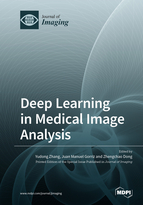Deep Learning in Medical Image Analysis
A special issue of Journal of Imaging (ISSN 2313-433X). This special issue belongs to the section "Medical Imaging".
Deadline for manuscript submissions: closed (31 December 2020) | Viewed by 124541
Special Issue Editors
Interests: deep learning; artificial intelligence; machine learning
Special Issues, Collections and Topics in MDPI journals
Interests: neuroimaging; statistical learning theory; biomedical signal processing; computer-aided diagnosis
Special Issues, Collections and Topics in MDPI journals
2. New York State Psychiatric Institute, New York, NY 10032, USA
Interests: structural mechanics; computational mechanics; contact mechanics; efficient solvers; interfaces; modeling; applications in mechanical and civil engineering
Special Issues, Collections and Topics in MDPI journals
Special Issue Information
Dear Colleagues,
Over the past years, deep learning has established itself as a powerful tool across a broad spectrum of domains in imaging, e.g., classification, prediction, detection, segmentation, diagnosis, interpretation, reconstruction, etc. While deep neural networks initially found nurture in the computer vision community, they have quickly spread over medical imaging applications.
The accelerating power of deep learning in diagnosing diseases will empower physicians and speed-up decision making in clinical environments. Applications of modern medical instruments and digitalization of medical care generated enormous amounts of medical images in recent years. In this big data arena, new deep learning methods and computational models for efficient data processing, analysis, and modeling of the generated data is crucially important for clinical applications and in understanding the underlying biological process.
The purpose of this Special Issue “Deep Learning in Medical Image Analysis” is to present and highlight novel algorithms, architectures, techniques, and applications of deep learning for medical image analysis.
Prof. Dr. Yudong Zhang
Prof. Dr. Juan Manuel Gorriz
Prof. Dr. Zhengchao Dong
Guest Editors
Manuscript Submission Information
Manuscripts should be submitted online at www.mdpi.com by registering and logging in to this website. Once you are registered, click here to go to the submission form. Manuscripts can be submitted until the deadline. All submissions that pass pre-check are peer-reviewed. Accepted papers will be published continuously in the journal (as soon as accepted) and will be listed together on the special issue website. Research articles, review articles as well as short communications are invited. For planned papers, a title and short abstract (about 100 words) can be sent to the Editorial Office for announcement on this website.
Submitted manuscripts should not have been published previously, nor be under consideration for publication elsewhere (except conference proceedings papers). All manuscripts are thoroughly refereed through a single-blind peer-review process. A guide for authors and other relevant information for submission of manuscripts is available on the Instructions for Authors page. Journal of Imaging is an international peer-reviewed open access monthly journal published by MDPI.
Please visit the Instructions for Authors page before submitting a manuscript. The Article Processing Charge (APC) for publication in this open access journal is 1800 CHF (Swiss Francs). Submitted papers should be well formatted and use good English. Authors may use MDPI's English editing service prior to publication or during author revisions.
Keywords
- artificial intelligence
- deep learning
- transfer learning
- deep neural network
- convolutional neural network
- multi-task learning
- biomedical engineering
- multimodal imaging
- semantic segmentation
- image reconstruction
- explainable AI
- healthcare
Related Special Issue
- Deep Learning in Medical Image Analysis, Volume II in Journal of Imaging (6 articles)









